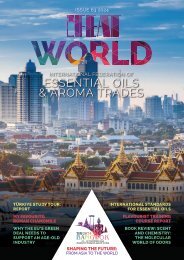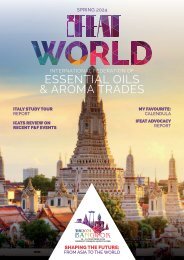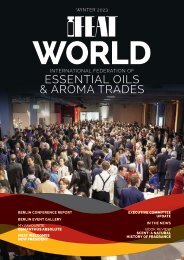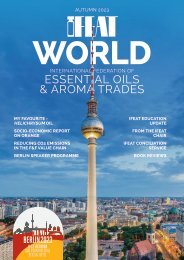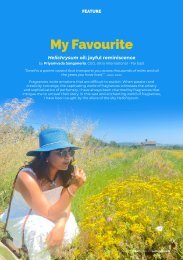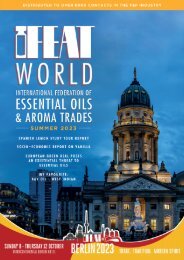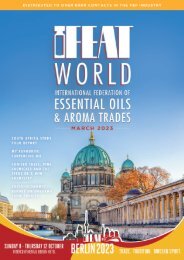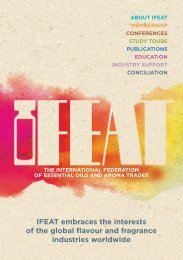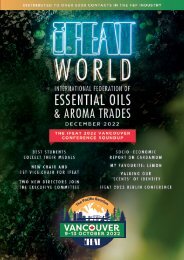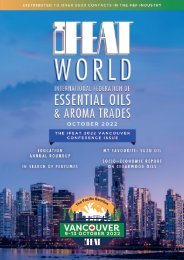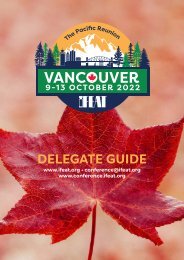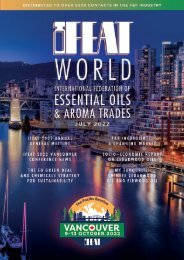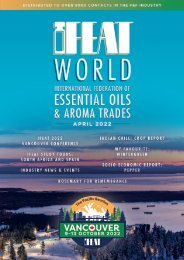IFEATWORLD June 2017
You also want an ePaper? Increase the reach of your titles
YUMPU automatically turns print PDFs into web optimized ePapers that Google loves.
WHERE THE WORLD COMES TO ITS SENSES<br />
Berjé has strived for excellence as a supplier of Essential Oils, and<br />
Aromatic Chemicals since our early days in New York City. In those six<br />
decades Berjé has built an inventory of over 3000 ingredients that covers<br />
the esoteric to the everyday. Rigorous QC standards, comprehensive<br />
traceability programs, and our recent SQF certification have established<br />
Berjé as a top tier distributor.<br />
With that foundation Berjé is breaking new ground on improving the<br />
industry’s standard of service. Coupled with Berjé Trakia, a European<br />
rose and lavender production facility, our global network of partners gives<br />
us the reach to sell in over sixty countries on six continents. As we further<br />
our commitment to promoting environmentally stable solutions, Berjé<br />
guarantees the quality of the past and the good sustainable business<br />
practices of the future.<br />
Berjé Inc. an SQF Level 3 Quality Certified Supplier<br />
+1 973 748 8980 | 700 BLAIR ROAD, CARTERET, NJ 07008 USA | WWW.BERJEINC.COM
WORLD 3<br />
ATHENS<br />
GREECE<br />
24-28 SEPTEMBER <strong>2017</strong><br />
FROM THE CONFERENCE CHAIRMAN<br />
DOMINIQUE ROQUES<br />
and will be a photographic review of all<br />
Congresses with IFEAT participation and<br />
IFEAT Conferences from 1979-2016.<br />
“I am delighted to report that within just<br />
one month of opening registration, we saw<br />
record bookings for the <strong>2017</strong> IFEAT Athens<br />
conference and by 1st July we had over<br />
1,000 registered delegates.<br />
We would like this year’s conference to<br />
be somewhat special as we will celebrate<br />
40 years since IFEAT’s inception in Kyoto<br />
in 1977 in the beautiful and historic city of<br />
Athens in Greece.<br />
Not only will we celebrate the history of<br />
IFEAT but we will take a few glimpses<br />
into the ongoing journey of 40 centuries<br />
of perfumery. We are fortunate to have<br />
gathered together an impressive range of<br />
talent to deliver some very interesting and<br />
fascinating presentations.<br />
Celebration will open the conference on<br />
Monday morning 25th September with a<br />
special presentation by Dr Wladyslaw<br />
S. Brud and Mr Richard C. Pisano<br />
Snr., who have been with IFEAT since the<br />
beginning. They will present 40 Years of<br />
IFEAT – The History; the first of two halfhour<br />
sessions looking back over the past<br />
40 years of IFEAT. Their second session<br />
will take place on Tuesday morning 26th<br />
To follow up on Monday, Jacques<br />
Cavallier, Master Perfumer for Louis Vuitton<br />
and Michael Carlos, President of IFRA will<br />
offer their highly experienced view on the<br />
past and future of perfumery and creation,<br />
while Professor Jean-Pierre Brun, from<br />
the Collège de France, will take us through<br />
a fascinating journey in our knowledge and<br />
discoveries of what Perfumery in Antiquity<br />
really was. You cannot be at the Athens<br />
conference and miss this!<br />
Our Monday afternoon session will deal<br />
with Challenges & Opportunities in<br />
Essential Oils from Africa to Greece with<br />
a focus on the future of East African gums,<br />
to be followed by a panel discussion which<br />
grows more animated every year…<br />
On Tuesday morning, IFEAT President Raúl<br />
Amigo will reveal the destination for the<br />
2018 IFEAT conference and we will have<br />
news of the 2018 Study Tour. IFEAT Study<br />
Tours are becoming increasingly popular<br />
and are usually fully booked within hours of<br />
registration opening.<br />
The Scientific session on Tuesday afternoon<br />
will look at hot topics like Pesticides and<br />
REACH and cover much in the fast-moving<br />
area of Regulation. Again, this will be<br />
followed by a panel discussion.<br />
There will be two one day workshops this<br />
year on Wednesday and Thursday – one<br />
on flavours and one on fragrance. More<br />
information about these excellent<br />
workshops can be found on page<br />
13 of this issue of <strong>IFEATWORLD</strong>.”<br />
Dominique Roques<br />
Athens Conference<br />
Committee Chairman.<br />
“I hope you enjoy reading the<br />
newly designed <strong>IFEATWORLD</strong>.<br />
In this issue, “My Favourite” is<br />
buchu oil by Stephen Pisano,<br />
the socio-economic report<br />
looks at frankincense and<br />
myrrh and Peter Greenhalgh<br />
continues his fascinating<br />
“History of IFEAT” series with<br />
part three, “Education & Study<br />
Tours”. There’s also a pull out<br />
programme for the Athens<br />
conference. If you would like to<br />
discuss editorial or advertising,<br />
please contact me, Tina<br />
Carne, by email at<br />
ifeatworld@ifeat.org”<br />
Tina Carne<br />
<strong>IFEATWORLD</strong> Editor.
4<br />
WORLD<br />
IFEAT:<br />
EDUCATION<br />
AND<br />
IFEAT: EDUCATION AND STUDY TOURS • HISTORY PART 3<br />
STUDY TOURS<br />
In this third instalment of the “History of IFEAT” series and following on from his “Early Years”<br />
article in the April <strong>2017</strong> issue of <strong>IFEATWORLD</strong>, Peter Greenhalgh takes a look at how Education<br />
and Study Tours have played important roles in IFEAT’s activities.<br />
“Education” was not included as one<br />
of the initial aims of IFEAT but, led by<br />
Murray-Pearce, the first Chair of IFEAT’s<br />
Education Committee, and later by Michael<br />
Boudjouk, the promotion of various aspects<br />
of education very soon played an important<br />
role in IFEAT’s activities. “Education” took a<br />
variety of forms, including supporting and<br />
helping to organise perfumery and flavour<br />
courses; organising lectures, workshops and<br />
discussion panels at IFEAT Conferences;<br />
circulating relevant information on F&F<br />
industry issues to members; and study tours,<br />
as well as sponsoring student attendance on<br />
various courses and conference attendance.<br />
For the past four decades, IFEAT has offered<br />
substantial support in terms of financial and<br />
technical resources, promotion and help in<br />
all these various educational areas.<br />
PERFUMERY EDUCATION<br />
The support of perfumery education was<br />
the first success story for IFEAT. Murray-<br />
Pearce worked closely with David Williams<br />
to launch the IFEAT supported Perfumery<br />
Education Centre (PEC) during the second<br />
IFEAT World Council meeting at the<br />
Cannes Congress in 1980. Williams,<br />
Director of the PEC, had since 1970<br />
pioneered a comprehensive open entry<br />
approach to perfumery education based<br />
on evening lectures at South East London<br />
College. However, the College was<br />
unable to obtain approval to offer a<br />
correspondence course in perfumery, which<br />
led to the setting up of the PEC in 1980<br />
offering the IFEAT diploma duly certified.<br />
The course provided a thorough introduction<br />
to perfumery and was particularly suitable<br />
to newcomers. IFEAT was very pleased to<br />
be associated with the PEC and strongly<br />
believed that education opens new avenues<br />
of personal achievement and would be the<br />
key to the industry’s future development and<br />
success.<br />
DAVID WILLIAMS<br />
In the 1980s, with the encouragement<br />
of IFEAT and other industry supporters,<br />
Williams completed the monumental task<br />
of writing a complete distance-learning<br />
package. It was designed to provide<br />
students with a recognised qualification<br />
and a firm grounding in the perfume<br />
industry enabling them to develop their<br />
careers. The duration of the course was<br />
normally one academic year during which<br />
students received detailed study notes and<br />
guidance. A programme of sensory work<br />
formed an integral part of the course and<br />
for this purpose students were supplied<br />
with aromatic materials and smelling strips.<br />
IFEAT’s role included assessing the special<br />
studies submitted by each student and<br />
awarding diplomas if the special study and<br />
coursework reached the required standard.<br />
Williams, along with IFEAT, set in motion<br />
a perfumery education programme that<br />
encompassed the world. The course was<br />
not only of interest to trainee perfumers but<br />
also attracted some of the big compounding<br />
companies who placed their newly<br />
recruited sales and marketing staff on the<br />
course. Some of the sons and daughters of<br />
owners of essential oil businesses also took<br />
the course. By 1984 some 196 students<br />
from 48 countries had registered for the<br />
course and already some 40 diplomas had<br />
been awarded, 26 at ordinary level and<br />
14 with distinction. Now, well in excess of<br />
1,000 people from many countries have<br />
participated in IFEAT sponsored perfumery<br />
and later flavour training programmes.<br />
While IFEAT provided financial support<br />
for the running of the perfumery and later<br />
flavour courses, IFEAT member companies<br />
also provided financial and material support<br />
and offered company visits.<br />
Following David Williams’s retirement in<br />
1993 the next phase began, involving<br />
an expansion in the number of perfumery<br />
courses. This initially involved a five-day<br />
residential workshop at Plymouth University<br />
Business School supported by IFEAT and<br />
The British Society of Perfumers (BSP).<br />
This led to the four-year BA degree in the<br />
Business of Perfumery at Plymouth Business<br />
School. Course management was now
WORLD 5<br />
STAFF AND STUDENTS<br />
Diploma in Perfumery Course 2003 - 04<br />
under the direction of Dr Tony Curtis, who<br />
had previously worked at Bush Boake Allen.<br />
With the support and advice of IFEAT and<br />
the BSP the new degree was validated and<br />
the first students graduated in 1998. IFEAT<br />
financial support was vital in supporting<br />
students. The degree course was restructured<br />
and transferred to the Science<br />
Department to become a four-year B.Sc in<br />
Aroma and Formulation Science.<br />
IFEAT made substantial annual donations<br />
to Plymouth to help support the course as<br />
well as fund library texts on perfumery<br />
and flavourings. The first BA graduates<br />
entered the industry in 1998. This course<br />
ran alongside the Diploma in Perfumery<br />
correspondence course. Plymouth also<br />
developed a flavouring module for the<br />
course, with Mike Boudjouk closely involved<br />
as IFEAT Education Coordinator. The<br />
courses were also supported by the BSP<br />
and the UK Society of Cosmetic Chemists.<br />
and Health Care’. IFEAT financial support<br />
also allowed Plymouth student attendance<br />
at the BSP New Materials for the Perfumer<br />
Symposium. Another key development<br />
was the introduction of CPD (Continuing<br />
Professional Development) where students<br />
could take selected modules to fit their<br />
career development plans.<br />
FLAVOURIST<br />
TRAINING PROGRAMME<br />
2002 saw the start of a six-week Flavourist<br />
Training Programme at the University of<br />
Reading, supported by IFEAT. Following<br />
initial teething troubles leading to a<br />
shortening and re-formatting of the course in<br />
2003, the course has continued to run until<br />
today and provides potential flavourists with<br />
the foundation to build a career.<br />
While the large international companies<br />
had their own flavourist training<br />
programmes, there are many smaller<br />
companies where flavourists receive little<br />
formal training. Hence, with a few notable<br />
exceptions, course participants have been<br />
from small to medium size companies.<br />
Over the first 15 years there have been<br />
156 participants from 44 countries. IFEAT’s<br />
publicity has helped significantly to make<br />
the course known throughout the world. Jack<br />
Knights of the British Society of Flavourists<br />
(BSF), supported by Prof Don Mottram from<br />
Reading, are the driving force behind the<br />
course.<br />
IFEAT: EDUCATION AND STUDY TOURS • HISTORY PART 3<br />
In 2009 Plymouth, with IFEAT support,<br />
started a new distance-learning programme<br />
and also, beginning in 2008 at the IFEAT<br />
Montreal Conference, Plymouth gave a oneday<br />
Perfumery Workshop, which continued<br />
at later conferences. Another IFEAT initiative<br />
made possible with IFEAT support was a<br />
Medical Elective at the Plymouth Peninsular<br />
Medical School on ‘Odours in Medicine<br />
FLAVOURISTS COURSE GROUP
6<br />
WORLD<br />
IFEAT: EDUCATION AND STUDY TOURS • HISTORY PART 3<br />
NECATI GULER, EC CHAIR PRESENTING<br />
CYNTHIA STEWART-STOKES (USA)<br />
BEST STUDENT PERFUMERY MEDAL AWARD<br />
EC visit to Plymouth 1995<br />
STUDENT EXCELLENCE<br />
MEDAL AWARDS<br />
In 1986 Mr Michael Boudjouk of<br />
Medallion International (long time Chairman<br />
of IFEAT’s Education Committee) proposed<br />
the IFEAT Students Excellence Award and<br />
Medal to be presented annually to the best<br />
students selected from groups supported by<br />
IFEAT. The first medal was awarded to Mrs<br />
A.P. Kallianpur from India at the Taormina,<br />
Sicily Conference in 1987 while the first<br />
flavourist student award was presented in<br />
Warsaw in 2002.<br />
OTHER IFEAT<br />
EDUCATIONAL ACTIVITIES<br />
Another important function of IFEAT was<br />
to circulate information and data to<br />
members. The IFEAT Newsletter, started in<br />
May 1980, was the major publication for<br />
dissemination, and in 2007 was replaced<br />
by <strong>IFEATWORLD</strong>. Also, in the late 1990s,<br />
IFEAT started its own website which has<br />
slowly evolved; IFEAT joined REACH-Ready<br />
as a means of disseminating REACH data;<br />
in 1994 IFEAT bought a complete set of<br />
the nine-volume F&F ingredient data sheet<br />
set compiled by FEMA, RIFM and the<br />
FMA, which contained safety information<br />
on over 1,500 raw materials used in the<br />
F&F industries and the data made available<br />
to members. In 1989 IFEAT published<br />
a “Guide Line for the classification and<br />
labelling of Essential Oils for transport and<br />
handling” (ed. by Klaus Dieter Protzen and<br />
sponsored by Paul Kaders GmbH.<br />
The organisation of full day courses/<br />
workshops at IFEAT Conferences is another<br />
educational initiative. Alongside the<br />
perfumery workshops, there have been<br />
workshops on essential oils (led by Brian<br />
Lawrence), REACH, flavour workshops (led<br />
by John Wright), international transportation<br />
of hazardous materials, short chiral course<br />
and medicinal plants.<br />
STUDY TOURS<br />
Another very successful feature of IFEAT<br />
educational activities has been the<br />
organisation of study tours for members.<br />
Over the past decade, IFEAT study tours<br />
have gone from strength to strength.<br />
They are proving to be a great learning<br />
experience – in the company of other<br />
industry specialists, who might be<br />
competitors but become good friends. This<br />
facilitates the growth of the international<br />
IFEAT family. While each study tour follows<br />
a similar format they remain very different,<br />
predominantly because of the country<br />
and companies visited as well as different<br />
participants.<br />
The study tours have a number of objectives.<br />
First, to gain a clearer understanding of the<br />
various processes, capabilities and set-up of<br />
different facilities producing and processing<br />
essential oils, aroma chemicals and F&F<br />
ingredients in the country being visited.<br />
Second, the tours provide opportunities for<br />
participants to meet up with key producers,<br />
processors, importers and exporters in the<br />
F&F sector in the country. Third, the tours<br />
enable participants to meet up with other<br />
knowledgeable F&F industry people from<br />
a variety of countries and continents. Each<br />
tour has been an incredibly international<br />
and multi-generational group. Travelling<br />
together over 6 to 12 days, the wide range<br />
of expertise and knowledge on hand make<br />
them remarkably useful and informative.<br />
Two study tours to China took place in<br />
1982 and 1987. However, the first was<br />
restricted to IFEAT Executive Committee<br />
members, although the initial plan for the<br />
1982 tour was for a greater number of<br />
participants but the Chinese authorities<br />
refused this. Even so, the 1982 three-week<br />
fact-finding tour was accorded diplomatic<br />
status and covered eight cities, including<br />
Beijing, Jiangsu, Guanxi, Yunnan and<br />
Guangdong.<br />
From Bejing, the IFEAT group went to<br />
Yunnan Province to visit plantations,<br />
distilleries and factories and then finished<br />
the tour at the Shanghai Research Centre to<br />
meet Dr Ding Desheng, Medal Lecturer at<br />
the Bejing Conference in 1988.<br />
The first IFEAT Study Tour, which was open<br />
to all IFEAT member companies, as well as<br />
non-members was to Sri Lanka in 2005,<br />
since when nine further study tours have<br />
taken place. Initially, each study tour was<br />
approximately one week in duration every<br />
two years, but following the success of the<br />
Italian and Indonesian tours, they became<br />
annual events ranging from six to twelve<br />
days and in recent years waiting lists have<br />
been established shortly after registration<br />
opened due to the high interest. The number<br />
of participants attending has varied; 2005:<br />
Sri Lanka (11 participants from 7 countries);<br />
2007: Egypt (13 from 9 countries); 2009:<br />
Southern Italy (30 from 13 countries); 2011<br />
Indonesia (40 from 19 countries); 2012<br />
Brazil (40 from 17 countries) and Paraguay<br />
(20 participants from 10 countries);<br />
2013: India (33 participants from 17<br />
countries); 2014: China (36 participants<br />
from 15 countries); 2015 France (44<br />
participants from 21 countries); 2016: USA<br />
(48 participants from 20 countries) and<br />
<strong>2017</strong>: Bulgaria (45 participants from 20<br />
countries). Since 2011 a book, usually in<br />
excess of 100 pages, has been published<br />
on each of the study tours, and on page<br />
14 there is an article on the recent Bulgaria<br />
Study Tour.<br />
To read the history article in full,<br />
please visit www.ifeat.org
Athens<br />
8<br />
WORLD<br />
MY FAVOURITE<br />
BUCHU OIL<br />
BY STEPHEN PISANO<br />
Executive Vice President Citrus and Allied Essences Ltd.<br />
MY FAVOURITE • BUCHU OIL<br />
Over the past 30 years I have smelled<br />
many essential oils, absolutes and aroma<br />
chemicals. Each note sparks a memory and<br />
is connected to an experience.<br />
With all the amazing essential oils, why<br />
choose buchu oil? In one word, GROWTH!<br />
I relate this oil to my early years of<br />
inexperience. The first time I smelled buchu<br />
oil, to my untrained nose it was not very<br />
pleasing. I could<br />
not imagine where<br />
it could be used or<br />
why anyone would<br />
use it, especially<br />
in flavour and fragrance applications! I<br />
loved to show it to junior perfumers and<br />
flavourists who were not familiar with it, just<br />
to see their reactions. I have heard many<br />
descriptors of buchu oil - some of which are<br />
not fit to print!<br />
Over the years, I learned to smell deeper<br />
and to recognise and appreciate the<br />
nuances in the oil; now when I smell buchu<br />
oil, I imagine the flavours and fragrances<br />
where it is used and could be used. I find<br />
myself looking for it in tropicals and exotics<br />
when evaluating flavours and fragrances<br />
with customers. Buchu oil is extremely<br />
powerful; a little goes a long way. It is<br />
typically added in solutions of less than<br />
10ppm in blackcurrant, passion fruit,<br />
grapefruit, mango,<br />
and other tropical<br />
and berry flavours.<br />
Although buchu oil<br />
imparts a very sulphury offensive off-note at<br />
higher levels, it is an essential ingredient for<br />
our industry thanks to the increased demand<br />
primarily in natural flavours. Organic<br />
buchu oil is also available and is mainly<br />
used in natural fragrance for personal care<br />
products.<br />
Buchu was traditionally used for ceremonial<br />
and cosmetic purposes in ancient times. It<br />
was first introduced to the Dutch settlers in<br />
South Africa in the 17th and 18th centuries<br />
as a herbal remedy and quickly spread to<br />
Europe. Dried buchu leaves, not oil, were<br />
exported to Europe in the early 1800s and<br />
“It was a great experience to stand<br />
in the field and witness the leaves<br />
being harvested by hand.”<br />
“Buchu oil is extremely powerful;<br />
a little goes a long way.”<br />
used to make natural health tonics to cure<br />
many ailments including rheumatism. It is<br />
still used today locally for numerous health<br />
related claims and can also be found in<br />
tea blends.<br />
The 2006 IFEAT Cape Town Conference<br />
gave me my first introduction to the<br />
plant itself when I visited a buchu farm.<br />
Connecting the oil to the actual plant and<br />
soil, to be able to pick<br />
a leaf, pinch it and<br />
smell the oil, put a face<br />
on it for me! It was a<br />
great experience to<br />
stand in the field and witness the leaves<br />
being harvested by hand.<br />
Buchu is a perennial shrub that is<br />
indigenous only to South Africa where<br />
it is growing wild and is cultivated both<br />
conventionally and organically in the<br />
Western Cape region. Buchu grows on<br />
slopes that are west and south facing at a<br />
minimum of 500 metres above sea level.<br />
The leaves are typically harvested from<br />
October through to May. Buchu likes a<br />
Mediterranean climate with an average<br />
rainfall of 770mm per year. For optimal<br />
oil yield, the leaves should be immediately<br />
steam distilled for 135 minutes after they<br />
are picked. It is important to note, Buchu<br />
- both betulina and crenulata - are part of<br />
the Fynbos (fine-leaved<br />
plants), the unique floral<br />
kingdom that occurs only<br />
in the Western Cape<br />
of South Africa. As a result, buchu is a<br />
protected species and permits are required<br />
to propagate, cultivate, harvest, transport<br />
and deal in it.<br />
Agathosma botulin, known as round leaf,<br />
and Agathosma crenulata, known as long<br />
or oval leaf, are the two main species of<br />
buchu that have been commercialised. In<br />
fact, there are as many as 150 species<br />
of buchu. Agathosma is derived from the<br />
Greek word “Agathos” meaning pleasant<br />
and “osme”, meaning fragrance. The<br />
preferred species is A. betulina because<br />
of its lower, naturally occurring pulegone<br />
level, which conforms to the EU regulatory<br />
restrictions on pulegone. However, in<br />
recent years, the demand for A. crenulata<br />
has significantly increased, along with the<br />
increased price level.<br />
Thirty years ago, buchu oil was considered<br />
to be a boutique oil. Ten years ago, the<br />
over commercialisation of the plant caused<br />
the price of the oil to drop. As a result,<br />
farmers began pulling up the plants and<br />
replacing them with more profitable crops.<br />
To date, the selling price is around 40% of<br />
the price of buchu when it was in its prime.<br />
Today, the demand for buchu oil remains<br />
strong; however, most recently, historic<br />
severe drought conditions and wildfires<br />
have led to shortages and higher prices!<br />
Welcome to the world of naturals, there’s<br />
always something! This may all seem boring<br />
to the average person but to all of you<br />
reading this, the next time you smell buchu<br />
oil, I hope you will have a newfound love<br />
for this very special oil.<br />
For further and technical information<br />
about buchu oil, may I refer you all to Dr.<br />
Matthias W. Esterhuysen’s paper; “Buchu<br />
Oil in South Africa” which was presented<br />
at the Cape Town Conference in 2006. It<br />
is available in the Conference Proceedings<br />
on the IFEAT website. A Big Thank You<br />
to my dear friends Michelle Starke from<br />
Moutons Valley Pty Ltd whose information<br />
on organic buchu oil and pictures were a<br />
huge help to me and to Catherine Crowley<br />
from Eucaforest (Pty) Ltd for her market<br />
insights.
Athens Agenda 4pg.qxp_Layout 1 25/07/<strong>2017</strong> 09:53 Page 2<br />
1977-<strong>2017</strong><br />
YEARS<br />
ATHENS<br />
GREECE<br />
24-28 SEPTEMBER <strong>2017</strong><br />
PROGRAMME<br />
www.ifeat.org<br />
conference@ifeat.org
Athens Agenda 4pg.qxp_Layout 1 25/07/<strong>2017</strong> 09:53 Page 3<br />
Athens<br />
PROGRAMME<br />
SATURDAY 23RD SEPTEMBER<br />
13.00 - 17.00 Registration of Delegates<br />
SUNDAY 24TH SEPTEMBER<br />
09.00 - 17.00 Registration of Delegates<br />
18.00 - 20.00 Welcome Cocktail Reception<br />
InterContinental Hotel<br />
MONDAY 25TH SEPTEMBER<br />
09.00 Conference Opening Ceremony<br />
Introduction by Dominique Roques, IFEAT Executive Committee and Chairman of the Athens Conference Committee<br />
09.15 – 09.45 (approx) Session One:<br />
40 Years of IFEAT – The History<br />
Part 1 of a joint presentation from Dr Wladyslaw S Brud and Richard C Pisano<br />
10.00 – 10.30 Naturals: the New Deal in Perfumery<br />
Jacques Cavallier-Belletrud, Perfumer at Louis Vuitton<br />
10.30 – 11.00 Coffee Break<br />
Sponsored by: The Lebermuth Company<br />
11.00 – 11.30 Session Two:<br />
Flavours & Fragrances – Today and Tomorrow<br />
Michael Carlos (Chairman of RIFM & IFRA)<br />
11.30 – 12.15 Perfume in Antiquity<br />
Professor Jean-Pierre Brun, Collège de France<br />
12.15 – 14.00 Lunch<br />
Sponsored by: Lansdowne Aromatics<br />
14.00 Session Three: Essential Oil Sources: Challenges & Opportunities<br />
14.00 – 14.45 Greece: Essential Oils, a Promising Business Opportunity in a Crisis Period<br />
Mr George Bouas<br />
14.50 – 15.15 Africa Rising: Naturals as a Challenge & Game Changer<br />
Catherine Crowley & Jalal Charaf<br />
15.20 – 15.45 Somalis’ Historical Frankincense Trade: Valuing Sustainability<br />
Anjanette Decarlo<br />
15.45 – 16.30 Discussion Panel<br />
16.30 Close for the Day<br />
Evening free
Athens Agenda 4pg.qxp_Layout 1 25/07/<strong>2017</strong> 09:53 Page 4<br />
PROGRAMME<br />
TUESDAY 26TH SEPTEMBER<br />
09.00 Session Four: IFEAT Business Meeting<br />
Chairman: Raúl Amigo, President of IFEAT<br />
Part 1 The IFEAT Annual General Meeting<br />
Part 2 Business Reports<br />
Annual Review:<br />
Antonella Corleone, Chair of IFEAT Executive Committee<br />
Reports on the IFEAT Education Programme<br />
ICATS/University of Plymouth Aroma Trades Course<br />
Dr Alison Green<br />
The University of Reading Flavour Course<br />
Report on IFEAT <strong>2017</strong> Bulgaria Study Tour<br />
IFEAT 2018 Conference<br />
Raúl Amigo<br />
IFEAT 2018 Study Tour<br />
09.45 – 10.15 40 Years of IFEAT – Congresses and Conferences<br />
Part 2 of a joint presentation from Dr Wladyslaw S Brud and Richard C Pisano<br />
10.15 Presentation of medals to the Best Students<br />
10.30 End of morning sessions<br />
Coffee Break. Sponsored by: The Lebermuth Company<br />
12.00 Lunch<br />
Sponsored by: Lansdowne Aromatics<br />
14.00 Session Five: Regulatory and Legislative Developments (title to be confirmed)<br />
Pesticides in Naturals<br />
Michel Meneuvrier, SAPAD<br />
REACH, 10 years of defending the EU market access for our naturals<br />
Julie Cena<br />
Safety Assessment<br />
Jim Romine, President of RIFM<br />
Limonene: Form a Calculated to a Data Based Hazard Classification for the Environment<br />
– The Impact on Essential Oils<br />
Hans Van Bergen<br />
Discussion Panel<br />
Jim Romine, Michel Meneuvrier, Kim Bleimann, Jens-Achim Protzen, Martina Bianchini (president IFRA).<br />
Moderator: Sven Ballschmiede (Executive Director IOFI)<br />
16.30 Dominique Roques to close programme<br />
Time tbc<br />
The IFEAT Annual Dinner at The Zappeion Hall
Athens Agenda 4pg.qxp_Layout 1 25/07/<strong>2017</strong> 09:53 Page 1<br />
PROGRAMME<br />
WEDNESDAY 27TH SEPTEMBER<br />
09.00 – 17.00 Trade Exhibition<br />
09.00 – 16.30 Workshop on Flavours & Flavourings (ticket only)<br />
Michael Zviely<br />
Course Sponsored by Ultra International Ltd<br />
Evening Free<br />
THURSDAY 28TH SEPTEMBER<br />
09.00 – 17.00 Trade Exhibition<br />
09.30 – 16.00 ICATS Intermediate Perfumery Workshop (ticket only)<br />
Joanna Norman<br />
Course Sponsored by P.T. Van Aroma<br />
18.15 Coaches commence Closing Banquet at Balux Prive<br />
for Closing Banquet Sponsored by Les Arômes du Maroc<br />
All timings are subject to change, for the most up to date agenda please visit: www.ifeat.org<br />
Programme designed by The Ark Design Consultancy Ltd
WORLD 9<br />
IFEAT/IFRA SOCIO-ECONOMIC<br />
IMPACT STUDY OF THE “NATURALS”<br />
FRANKINCENSE<br />
Both frankincense and myrrh (F & M)<br />
grow as small trees or shrubs; they are<br />
of the botanical family Burseraceae.<br />
Frankincense (also called olibanum) is<br />
classified as belonging to the Boswellia<br />
genus, while myrrh is obtained from<br />
trees of the Commiphora species. The<br />
nomenclature of these products is both<br />
complex and confusing. Thus, there are<br />
numerous species and varieties of F & M<br />
trees, each producing a slightly different<br />
type of resin. Differences in soil and climate<br />
create even more diversity of the resin,<br />
even within the same species. The primary<br />
species relied upon today are Boswellia<br />
carterii (Somalia) and Boswellia papyrifera<br />
(Ethiopia) for frankincense and Commiphora<br />
myrrhae for myrrh. Pappas (2016) argues<br />
that frankincense should also be classified<br />
by chemotype as well as species, and<br />
discusses the five main chemotypes that<br />
encompass the five main species.<br />
IMPACT CATEGORY:<br />
High impact, many people involved.<br />
Political instability, combined with<br />
geographic isolation and the nomadic<br />
nature of much of the collection area,<br />
makes it almost impossible to get accurate<br />
data. According to Farah (1994),<br />
officials of the Frankincense and<br />
Gums Development and Sales<br />
Agency reasonably estimated<br />
that the number of families in<br />
northern Somalia alone that<br />
primarily depend upon incense<br />
gathering is around 10,000<br />
and the occurrence of commercial<br />
frankincense, “is absolutely crucial to<br />
the subsistence of a large number of the<br />
regional population”.<br />
AND<br />
MYRRH<br />
the financing of significant events such as<br />
weddings, funerals or for the purchase<br />
of food stocks.”<br />
RELEVANT SITE<br />
LOCATION:<br />
F & M are tree resins produced in East<br />
Africa, particularly Ethiopia, Somalia,<br />
Somaliland and Puntland, the southern<br />
Arabian Peninsula, particularly Yemen and<br />
Oman, and the Sahelian region of Africa.<br />
Other producing countries include Sudan,<br />
Kenya, Chad, Central African Republic,<br />
Cameroon and Uganda. The trees are<br />
found in very exposed and arid or semi-arid<br />
regions with poor organic soil composition.<br />
FARMED OR FORAGED:<br />
Foraged. Most resin (whether F or M) is<br />
obtained either by collecting the exudate<br />
or more commonly by the tapping<br />
of wild growing trees. Tapping<br />
BOSWELLIA TREE<br />
involves making deliberate incisions into<br />
the bark of the tree. The resin is left to<br />
exude from the tree and harden for a few<br />
days. The collector then returns to collect<br />
the hardened gum and re-mark the tree for<br />
more gum to start exuding. Resins are usually<br />
collected every 10 to 15 days.<br />
F & M is predominantly a traditional trade<br />
undertaken by nomadic communities<br />
and networks that has been in existence<br />
for thousands of years. Tapping is done<br />
by traditional means by indigenous<br />
communities, including local farmers and<br />
villagers, with nomadic traditions and is<br />
often undertaken alongside other activities,<br />
including herding. Collection is, at times,<br />
carried out by pastoralist peasants who<br />
include poor members of the community,<br />
women and/or children, as they collect<br />
water and wood fuel or tend small stock, or<br />
by organised tappers/collectors. It is not an<br />
organised or agricultural type of harvesting,<br />
but rather a wild craft method.<br />
IFEAT/IFRA SOCIO-ECONOMIC IMPACT STUDY OF THE “NATURALS” • FRANKINCENSE AND MYRRH<br />
More recently, in 2013, Zahra Osman of<br />
Neo Botanika (Somaliland) stated that, “For<br />
many villagers, the collection of gum often<br />
represents their only opportunity to earn<br />
cash and this is particularly important for
10<br />
WORLD<br />
IFEAT/IFRA SOCIO-ECONOMIC IMPACT STUDY OF THE “NATURALS” • FRANKINCENSE AND MYRRH<br />
BOSWELLIA SACRA TREE - FRANKINCENSE RESIN<br />
(Ceroni, 2005; Chikamai and Casadei<br />
eds. 2005; Farah, 1994; Lemenih et al<br />
2007, Chaudhry, 2016, Guelleh 2016<br />
and Harris 2016).<br />
HARVEST TIMING:<br />
The collection of the resin occurs at a<br />
particular time and season, varying<br />
between regions. The gum activity is<br />
concentrated during the very low vegetative<br />
activity period when the trees have no<br />
leaves. Tapping occurs during the dry<br />
season from trunks and branches. The<br />
particular details of the tapping, such as the<br />
time of year it is undertaken, its duration,<br />
and the interval between individual<br />
tapping, varies according to the species<br />
and the customs in the area of production.<br />
For example, in Somalia there are usually<br />
two periods when Boswellia is tapped,<br />
each lasting three to four months, involving<br />
successive tapping at approximately 15-<br />
day intervals, with the timing of the tapping<br />
periods dependent upon the onset and<br />
extent of the rains.<br />
LOCATION OF<br />
PROCESSING:<br />
After the gum has been tapped and<br />
collected into bags and packaging, the<br />
villagers or farmers collect the gum and<br />
store it in an excavation, cave or some kind<br />
of camp, to accumulate for some time while<br />
they are harvesting in a certain region. This<br />
probably contributes to the stabilisation<br />
of the gum resin. Finally, after sufficient<br />
quantities have been collected, they are<br />
brought to the village or town, where the<br />
material is classified, graded and traded.<br />
All this is done manually. The resin is stored<br />
for about 12 weeks to harden. The only<br />
processing undertaken after collection is the<br />
sorting and grading of the resin globules.<br />
This is usually done by the local merchant to<br />
whom it is sold rather than by the collector.<br />
The cleaning process is undertaken in<br />
the collection centres where the primary<br />
material ranges from being as white as milk<br />
to a deep dark red. Following cleaning,<br />
sieving, sorting and picking, the material<br />
finally ends up graded by colour or size.<br />
After the material is cleaned, the trader<br />
comes to negotiate the purchase and<br />
export of the product. Most of the product<br />
is exported in this form, although there is a<br />
local market for chewing frankincense.<br />
Further processing is predominantly<br />
undertaken in the importer’s country and<br />
depends on usage. The resins are used in<br />
unprocessed form for both fragrance and<br />
flavour purposes, distilled to yield volatile<br />
oils with characteristic and balsamic odours<br />
used in perfumery. Solvent extracts are also<br />
prepared as resinoids and absolutes used<br />
as fixatives in perfumes. Although the bulk<br />
of processing was undertaken outside the<br />
gum-producing countries, processing plants<br />
have been set up in Somaliland, Kenya and<br />
Oman. This indicates a clear evolution in<br />
the F & M supply chain.<br />
Typically, frankincense is produced by<br />
water distillation and not usually by steam<br />
injection, with diesel thought to be the<br />
major energy source. Oil yields from<br />
processing appear to vary considerably<br />
and Pappas (2016) quotes the following<br />
oil yields. Boswellia serrata, primarily of<br />
Indian origin, is often very rich in oil content<br />
with oil yields of around 10% or more.<br />
High oil yields and low odour quality result<br />
in low prices. Boswellia sacra, which is<br />
typically from Oman and is an oil-rich<br />
resin, yields around 9-10%. Boswellia<br />
carterii and Boswellia frereana, usually<br />
from Somaliland, typically has oil yields of<br />
5-6% and around 2% range respectively.<br />
Boswellia papyrifera from Ethiopia has<br />
approximately a 2% oil yield.<br />
DISTINGUISHING<br />
CHARACTERISTICS:<br />
The markets and end-uses for the resins fall<br />
into three main sectors: fragrance (chiefly for<br />
incense use – either in religious ceremonies<br />
or around the home but with some fine<br />
fragrance applications); flavour (principally<br />
‘maidi type’ for chewing but with some<br />
minor uses of the oils as flavouring agents<br />
such as mouthwashes); and pharmaceutical<br />
applications. Both F & M were known<br />
for centuries in folk medicine and are<br />
used now in some medical products and<br />
in aromatherapy in the form of resins<br />
(incenses), oleoresins and essential oils.<br />
All of the products show antimicrobial<br />
properties and for that purpose were and<br />
are widely used in Chinese and Ayurveda<br />
medicine. Frankincense is also used to<br />
relieve depression and anxiety and myrrh<br />
has analgesic properties and is used in the<br />
treatment of rheumatic pain and arthritis.<br />
Both are present as additives to mouth care<br />
products and toothpastes and are also used<br />
in a variety of skin care products. Incense<br />
was commonly used to disinfect air in<br />
churches and homes and this tradition has<br />
remained until recently in different religious<br />
liturgies. Incense is, without question, its<br />
greatest use, and in addition to Eritrean-type<br />
frankincense being used by the Orthodox<br />
and Roman Catholic Churches, China<br />
is believed to be using an increasing<br />
proportion of its imports for the manufacture<br />
of incense sticks rather than, as previously,<br />
for traditional medicines.<br />
The F & M markets operate under various<br />
constraints and challenges. Some of the<br />
production constraints include: inconsistent<br />
quality, tapping or cleaning processes<br />
leading to variable grades; regulatory<br />
measures and forest management<br />
programmes and practices are often poor<br />
or lacking, reflecting the poverty of the<br />
regions; land degradation, clearance and<br />
use of wood for fuel can, in the long term,<br />
threaten supplies, if unabated; climatic<br />
changes, which can affect the timing and<br />
length of the dry season when harvesting<br />
isundertaken; deforestation, livestock<br />
over-grazing and changes in land use, will<br />
affect production levels; political instability,<br />
military and border conflicts, particularly<br />
in Somalia and between Ethiopia and<br />
Eritrea; lack of tree tenure in some countries<br />
to guarantee incentives to farmers and<br />
pastoralists in order to conserve and<br />
manage the woodlands. In addition, Sadqa<br />
Haq recently argued that NGO provision<br />
of food to nomads in the Horn of Africa<br />
during the last drought five years ago was<br />
reducing the incentive to collect resins.<br />
She now reports that the situation on the<br />
ground has changed and the pastoralists<br />
have formed collectors’ groups, especially<br />
in north eastern Kenya, and are more
WORLD 11<br />
focused on obtaining high quality resins<br />
for the markets. This change in attitude is<br />
very promising for the conservation of the<br />
indigenous resin producing trees.<br />
There are also various marketing constraints,<br />
which include changes in market demand,<br />
little marketing or trade registration<br />
(including very limited export or import<br />
statistics) and the threat from synthetic<br />
products. However, the use of F & M<br />
depends on their characteristic fragrance<br />
properties rather than functional properties<br />
and this makes it much more difficult for<br />
them to be substituted.<br />
VOLUMES:<br />
Frankincense is traded in the greatest<br />
volumes and is available in the largest<br />
number of different grades. It ranges in<br />
appearance from pale pieces or tears up<br />
to several centimeters in size, to smaller<br />
pieces, and from powder and siftings to<br />
large, reddish-brown or dark agglomerated<br />
masses. Myrrh is traded in smaller volumes<br />
and has fewer clean, pale grades to<br />
choose from. All the resins have a fragrant<br />
aroma due to the presence of essential<br />
oil and this accounts for their commercial<br />
importance.<br />
It is difficult to trace the exact volume of<br />
trade in F & M. In very recent years, France,<br />
the UK and the USA have been reported<br />
as sizeable importers of frankincense resins<br />
for further processing. Delauney (2010)<br />
estimated that at least 400 MT per year<br />
(and probably more) of the carterii or sacra<br />
type goes into the fragrance industry. This<br />
canbe differentiated from the Ethiopian<br />
type, which is exported in much larger<br />
volumes and thus the Eritrean or church type<br />
of frankincense accounts for the majority<br />
of incense tradedaround the world.<br />
Delauney estimates that averageannual<br />
exports over the two decades (1987 to<br />
2006) of B. carterii and B. sacra from<br />
Somalia, Somaliland and Puntland have<br />
averaged460MT, while exports of B.<br />
frereana havebeen between 50 and 70<br />
MT. Yemen and Omanare estimated to<br />
export approximately 120MTeach year of<br />
B. carterii and B. sacra and 60MT of B.<br />
frereana, including an unknown quantity<br />
of gum resins that originate from Somalia/<br />
Somaliland and transit through these<br />
countries. Exports of frankincense from<br />
Ethiopia and Eritrea are much larger, with<br />
annual exports of B. papyrifera estimated<br />
at 2,300MT with a further 700 to 800MT<br />
from other sub-Saharan producers. More<br />
recently, Guelleh (2016) has estimated<br />
current annual Somaliland harvesting levels<br />
and potential as follows: B. carterii gum<br />
resin production 200 MT to potentially<br />
around 1,000 MT; B. frereana gum<br />
production 150 MT to potentially 400 MT;<br />
myrrh production 90 MT to potentially 400<br />
MT; and opoponax current production 6<br />
MT to potentially 40 MT. Harris (2016),<br />
while recognising the inadequate data,<br />
discusses the substantial fall in Omani<br />
frankincense annual production to around<br />
30 MT, with harvesting totally dependent<br />
upon immigrant Somali labour.<br />
Coppen in Chikamai and Casadei eds.<br />
(2005) stated “Total world demand is<br />
estimated at around 2,500 tonnes/year but<br />
this figure is subject to some qualification<br />
and much uncertainty. China and Europe<br />
are the largest markets but the Middle East,<br />
North Africa and (to a lesser degree) the<br />
US also import significant amounts directly<br />
from source.”<br />
Today, with no official statistics with regard<br />
to export destinations, one can safely argue<br />
that China and the Middle East (and to a<br />
lesser extent Europe) have definitely become<br />
the largest importers. Although a significant<br />
proportion of imports in the Middle<br />
East are re-exported, China purchases<br />
for medicinal applications and also for<br />
burning incense sticks, whereas Europe<br />
and America use a similar type of incense<br />
(the Eritrean type) in the Orthodox and<br />
Roman Catholic Churches. The Northern<br />
African and Middle East destinations import<br />
the “Maidi” and the “Luban Maidi” for<br />
chewing gum and there are sizeable sales<br />
in local markets for chewing uses. France<br />
is certainly the leading importer of the<br />
B. carterii or B. sacra for perfumery and<br />
fragrance use, including essential oils and<br />
resinoids. In recent years, the popularity<br />
of aromatherapy and self-medication with<br />
essential oils has contributed significantly<br />
to a rise in the international demand for<br />
frankincense and myrrh. Similarly Boswellia<br />
resins are used for their antiseptic, antiarthritic<br />
and anti-inflammatory effects, while<br />
recent German, Indian and US research has<br />
indicated their use as a possible treatment<br />
for cancer.<br />
COMMIPHORA<br />
MYRRHA (MYRRH)<br />
IFEAT/IFRA SOCIO-ECONOMIC IMPACT STUDY OF THE “NATURALS” • FRANKINCENSE AND MYRRH
12<br />
WORLD<br />
IFEAT/IFRA SOCIO-ECONOMIC IMPACT STUDY OF THE “NATURALS” • FRANKINCENSE AND MYRRH<br />
REFERENCES:<br />
Frankincense and Myrrh<br />
• Basar, S., “Phytochemical Investigations<br />
on Boswellia Species”, Dissertation,<br />
Hamburg University (2005).<br />
• Ceroni, M., 2005. Viability of a<br />
Sustainable Frankincense Market In<br />
Somaliland: A Historical and Economical<br />
Analysis. Ashley Hall Ethnobotany<br />
12/2/05 pp.12.<br />
• *Chaudry, Ashad, 2016. Can<br />
Frankincense Oil be Produced<br />
Sustainably? Lessons Learnt from the<br />
Dhofar Region of Oman.<br />
• Chikamai, B. and Casadei, E., 2005.<br />
Editors. Production and Marketing of<br />
Gum Resins: Frankincense, Myrrh and<br />
Opoponax. NGARA Publication Series<br />
5/09/2005, pp. 97.<br />
• Coppen, J. J. W., author of several<br />
publications on gums. Formerly Natural<br />
Resources Institute (NRI), Chatham UK.<br />
• Delaunay, G., 2010. Incense: Supplies<br />
and Markets. In: IFEAT International<br />
Conference 2010. Marrakech, 26 – 30<br />
September 2010. London: IFEAT.<br />
• Dharmananda, S, Ph.D., 2003. Myrrh<br />
and Frankincense (Director, Institute for<br />
Traditional Medicine, Portland, Oregon<br />
(www.itmonline.org/arts/myrrh.htm)<br />
May 2003.<br />
• Dolara, Piero et al. (1996). “Analgesic<br />
effects of myrrh”. Nature. 379 (6560):<br />
29<br />
• Farah, A.Y., 1988. The Milk of the<br />
Boswellia Forests: Frankincense<br />
Production Among the Pastoral Somali.<br />
Thesis, London School of Economics and<br />
Political Science, University of London,<br />
U.K. 382 pp. Somali Academy of<br />
Sciences, Mogadishu, Somalia. (Edited<br />
version publ. 1994, Department of<br />
Social and Economic Geography,<br />
Uppsala University, xiv + 142 pp.).<br />
• *Guelleh, Osman Guelleh 2016, The<br />
Incense Trail: A Supply Chain in Flux<br />
• Haq, S., Managing Director of<br />
Lubanchem Ltd., Nairobi, Kenya<br />
www.lubanchem.com (Email Sadqa Haq<br />
sadqahaq@me.com). She is responsible<br />
for the production, quality assurance<br />
and overall running of the company. She<br />
has extensive experience in the<br />
distillation of essential oils from gums<br />
and resins, especially those from the<br />
genus Boswellia and Commiphora. She<br />
has been attending IFEAT conferences for<br />
the last eight years and has participated<br />
in the four study tours.<br />
• *Harris, Trygve, 2016, The Mother of<br />
Society and the Umbrella of our Lives:<br />
Frankincense in the Sultanate of Oman.<br />
• Lemenih, M, Feleke, S. and Tadesse,<br />
W., 2007. Constraints to smallholders<br />
production of frankincense in Metema<br />
district, North-western Ethiopia. Journal<br />
of Arid Environments, 71 (4), Dec 2007,<br />
pp. 393 – 403.<br />
• Moussaieff, A; Gross, M; Nesher, E;<br />
Tikhonov, T; Yadid, G;<br />
(2012).”Incensole acetate<br />
reduces depressive-like behavior<br />
and modulates hippocampal BDNF<br />
and CRF expression of submissive<br />
animals”. Journal of<br />
Psychopharmacology. 26 (12):<br />
1584– 93<br />
• NGARA (Network for Natural Gums<br />
and Resins in Africa) www.ngara.org<br />
Ben Chikamai benchikamai@ngara.org<br />
Sheila Mbiru sheilambiru@ngara.org<br />
c/o Kenya Forestry Research Institute,<br />
Nairobi, Kenya.<br />
• Ms. Zahra Osman Guelleh, Neo<br />
Botanika, Hargeisa, Somaliland –<br />
Traders in aromatic gums and resins<br />
and their essential oils. Email –<br />
zahra.osman@ogfgroup.com, UK<br />
phone number +44 78 764 4161.<br />
See interview on www.ifra.org where<br />
she discusses aromatic gums in<br />
Somaliland. She has worked for<br />
UN agencies – and is familiar with<br />
“sustainable livelihoods” concepts.<br />
She attends IFEAT conferences<br />
every year.<br />
• Dr Robert S Pappas 2016,<br />
“Frankincense – A classification by<br />
chemotypes rather than just species”<br />
Ultra International BV www.ultranl.com<br />
/frankincense-essential-oil-chemotypes<br />
• Starlight Products<br />
(www.starlightproducts.com) a<br />
specialised international trading<br />
company in botanicals, natural raw<br />
materials and ingredients and is part<br />
of the Iranex Group and based in<br />
Rouen, France.<br />
*Papers presented at IFEAT Dubai<br />
Conference 25th to 29th September<br />
2016, “The Middle East: Challenges at the<br />
Historical Crossroads of the F&F Trade”
WORLD 13<br />
TWO WORKSHOPS<br />
IN ATHENS<br />
PLACES STILL AVAILABLE<br />
There are still places left on the workshops we have in Athens<br />
this year and there is still time to book your place.<br />
Two workshops will be run this year – one on flavours<br />
and the other on perfumery.<br />
On Wednesday 27th September<br />
DR MICHAEL ZVIELY’S<br />
WORKSHOP ON FLAVOURS<br />
& FLAVOURINGS:<br />
• Flavours, Flavourings and Sweet Taste Modifiers.<br />
• Flavour Creation – main principles.<br />
• Flavours Stability and Changes During Shelf Life.<br />
• Flavourings and Interactions with Food and<br />
Beverage Matrices.<br />
• Gas Chromatography Mass Spectrometry<br />
(GCMS) as a Tool for Development of<br />
Flavourings.<br />
On Thursday 28th September,<br />
JOANNA NORMAN’S<br />
INTERMEDIATE<br />
PERFUMERY WORKSHOP:<br />
Both workshops will run from 09.30 until<br />
approx 16.00 and are by ticket only.<br />
Members: 200 EUR per workshop.<br />
Non-Members: 300 EUR per workshop.<br />
Plus VAT at the Greek rate of 24%<br />
For more information on the workshop leaders<br />
and to book your place, please visit<br />
www.ifeat.org/project/courses-workshops<br />
TWO WORKSHOPS IN ATHENS • PLACES STILL AVAILABLE<br />
• Odour Language and Fragrance Ingredients:<br />
An interactive multi-sensory exploration of<br />
communicating and classifying key natural and<br />
synthetic fragrance ingredients.<br />
• Fragrance Accords: Introduction of modern<br />
fragrance families, following an olfactory journey of<br />
over a hundred years of fragrance developments.<br />
• Creative Drivers and Key Trends: Smelling the<br />
creative triggers in recent fragrance launches and<br />
how they influence fragrance development from<br />
niche perfumery to household products.<br />
• Fragrance Creation Exercise: A practical session<br />
of fragrance creation developing a take home<br />
perfume composition.<br />
NEW TO IFEAT<br />
CONFERENCES<br />
On Wednesday 27th September from<br />
17.30 to 19.30, a discussion workshop<br />
will be organised around “What Future<br />
for Olibanum and Myrrh in Somaliland?”,<br />
to allow an in depth follow up to Dr<br />
Anjanette Decarlo’s presentation on<br />
Monday 25th September. Open to<br />
a limited number of Delegates upon<br />
registration, more news about this will be<br />
available on our website in the coming<br />
weeks and we will send information by<br />
email soon. Please visit our website at<br />
www.ifeat.org for more information.
14<br />
WORLD<br />
IFEAT STUDY TOUR TO<br />
BULGARIA<br />
28th MAY - 2nd JUNE <strong>2017</strong><br />
IFEAT STUDY TOUR TO BULGARIA • 28th MAY - 2nd JUNE <strong>2017</strong><br />
On the last weekend in May, 45 delegates<br />
from 20 countries gathered in rain-soaked<br />
Sofia for the start of IFEAT’s 10th Study<br />
Tour to Bulgaria. With them, the delegates<br />
brought the sunshine; the rains from the<br />
previous week disappeared and there<br />
followed five days of almost perfect weather<br />
– making the precautionary Wellington<br />
boots ordered for each delegate for the<br />
rose field visits unnecessary. Sadly, the<br />
originally planned onward trip to Turkey<br />
had to be cancelled due to security<br />
concerns. As a result, this study tour was the<br />
shortest to date. Although the programme<br />
was packed, the range of oils and extracts<br />
covered was limited. Nevertheless, as the<br />
comments from participants illustrate, this<br />
was one of the best study tours to date.<br />
Here are just a few of the comments from<br />
the Bulgaria Study Tour (BST)<br />
“Thank you all for the beautiful journey<br />
to the Valley of Roses. We enjoyed the<br />
tour and thank you all for making this yet<br />
another memorable tour.”<br />
“Thanks for organising the Tour, which was<br />
a really wonderful journey of rose!”<br />
“The BST went like clockwork, largely due<br />
to the meticulous organization.”<br />
“Thank you all for wonderful experiences<br />
these five days. Thanks to Filip and Andrey<br />
for their hospitality. I have never seen<br />
anybody so open in sharing process details<br />
and other technical information. It’s been a<br />
wonderful journey.”<br />
“Thank you ALL for this successful and<br />
rewarding experience, the camaraderie<br />
amongst us was off the charts. In terms of<br />
rose and lavender oil knowledge, my first<br />
study tour was stellar.”<br />
The tour concentrated on rose and<br />
lavender oils, in which Bulgaria is the<br />
world’s leading producer. During the five<br />
days, participants were able to gain an<br />
intimate knowledge of their production and<br />
processing, alongside some smaller oils.<br />
The tour provided an excellent opportunity<br />
for the participants to meet Bulgarian<br />
producers, processors and exporters as well<br />
as discuss a whole range of F&F topics with<br />
other delegates from a diversity of countries<br />
and backgrounds. Everyone was there to<br />
learn and to have a hands-on experience!<br />
The timing of the tour was perfect, with<br />
early morning visits to the rose fields<br />
enabling delegates to experience and<br />
participate in the picking of the flowers<br />
during the season’s peak! Unfortunately it<br />
was too early in the season to witness the<br />
harvest and distillation of lavender, which<br />
takes place a month later. Nevertheless, the<br />
participants enjoyed visiting the lavender<br />
fields, which had just started to bloom.<br />
Touring the Rose Valley, participants were<br />
able to see Bulgaria’s beautiful physical<br />
landscape and culture during their travels,<br />
in part thanks to the sponsorship of the<br />
Bulgarian companies we visited. IFEAT<br />
would like to thank Berje Trakia Ltd.,<br />
Bulattars Ltd., Enio Bonchev Production<br />
Ltd., Galen-N Ltd., Rosa Eterna Ltd. and<br />
Vigalex Ltd. for their sponsorship, as well<br />
as BalkaNova Ltd., the tour agent who<br />
provided excellent support and logistics.<br />
However, particular thanks must go to two<br />
Local Organising Committee members,<br />
Filip Lissicharov (Enio Bonchev) and Andrey<br />
Mitov (Vigalex), who accompanied the tour<br />
throughout the week, for their dedication<br />
and hospitality. As one delegate said<br />
of them; “I have never seen anybody so<br />
open in sharing process details and other<br />
technical information.” This, combined<br />
with company visits, the “coach lectures”<br />
and the professionalism and warmth of the<br />
welcome, meant that delegates gained an<br />
intimate knowledge of Bulgarian essential<br />
oil production, processing, marketing and<br />
end uses. One innovation introduced on the<br />
first day of the tour in Plovdiv was a series<br />
of five lectures on topics covering various<br />
aspects of Bulgaria’s essential oil industry.<br />
A visit to Rosa Impex, a major producer<br />
and exporter of a wide range of cosmetics,<br />
followed this.<br />
On Tuesday, delegates visited rose<br />
growing fields and then the operation of<br />
Galen-N and Kateko, where another Local<br />
Organising Committee member, Morntchil<br />
Mihov, provided a detailed guide to the<br />
company’s growing, distillation, concrete<br />
and absolute extraction operations. This<br />
tour included a visit to new pharmaceutical<br />
ingredient production facilities as well as a<br />
lunchtime lecture on dry rose flower extract.<br />
In the afternoon, a visit was made to Rosa<br />
Eterna’s essential oil processing facilities.<br />
Wednesday began with a very early<br />
morning visit to Enio Bonchev’s rose picking<br />
operation with stunning views overlooking<br />
the Rose Valley. Delegates were shown the
WORLD 15<br />
IFEAT BULGARIA STUDY TOUR DELEGATES <strong>2017</strong><br />
new high tech software facilities monitoring<br />
rose harvesting and then competed in a<br />
rose picking competition. At both Enio<br />
Bonchev and Bulattars, (which was visited<br />
in the afternoon), delegates were given<br />
in-depth tours of each company’s new and<br />
old distillation facilities, as well as their<br />
impressive rose museums. The detailed<br />
description of the uncommon cohobation<br />
technique, used to distil rose oil, was very<br />
interesting. Delegates also saw rose oil<br />
being very carefully decanted from the<br />
still, not surprising when the current price<br />
is approximately €12,000 per kg! The<br />
final day saw visits to Vigalex’s rose and<br />
lavender fields and its modern processing<br />
and extraction facilities. This was followed<br />
by a plant visit to Panteley Toshev Ltd. – an<br />
innovative and technological leader in the<br />
production of beverage, food and natural<br />
flavour ingredients. Throughout the tour,<br />
delegates received generous gifts from the<br />
companies they visited.<br />
Cultural activities were not overlooked. The<br />
tour began with a tour of Sofia riding on<br />
a traditional tram. Other events included<br />
walking tours of historic Sofia and Plovdiv;<br />
an evening reception and dinner at the<br />
superb Kazanlak Rose Museum with the<br />
Mayor; visits to the Thracian tombs (a<br />
UNESCO Heritage Site); several folk<br />
dancing and singing displays in traditional<br />
costumes and a dinner accompanied by<br />
a superb male voice choir. Throughout the<br />
tour, delegates sampled the magnificent<br />
Bulgarian hospitality, wine and cuisine<br />
beginning with a welcome dinner on a<br />
roof-top restaurant with stunning views over<br />
Sofia as the sun set, and concluding with<br />
a rose themed closing banquet with fine<br />
Bulgarian wines – a spectacular end to<br />
another successful IFEAT study tour.<br />
Peter Greenhalgh is currently preparing<br />
a book on the Bulgaria Study Tour, which<br />
will be available later this year.<br />
IFEAT STUDY TOUR TO BULGARIA • 28th MAY - 2nd JUNE <strong>2017</strong>
NEW IFEAT MEMBERS<br />
Below is a list of new IFEAT members who had joined by 1st <strong>June</strong> <strong>2017</strong>:<br />
Colgate-Palmolive<br />
909 Rover Road, Piscataway, New Jersey 08855<br />
USA<br />
Contact:<br />
Email:<br />
Web:<br />
Ms Tracy Bariexca<br />
tracy_bariexca@colpal.com<br />
www.colgate.com<br />
Jayshree Aromatics Pvt. Ltd.<br />
Plot No: 4703, 4704, 4705/1/2, 3, 4,<br />
G.I.D.C. Estate, Ankleshwar, Gujarat 393002<br />
India<br />
Contact:<br />
Email:<br />
Web:<br />
Mr Neel Patel<br />
neel@jayshreeind.com<br />
www.jayshreeind.com<br />
Tianmen Deyuan Chemical Tech Co., Ltd.<br />
No.58 Chuangye Road, Economic Development Zone,<br />
Tianmen, Hubei 431700<br />
China<br />
Contact:<br />
Email:<br />
Web:<br />
Mr Li Jijian<br />
lijijian@deyuanchem.cn<br />
www.deyuanchem.cn/template/company.htm<br />
DCP Ltd<br />
29 Abercromby Place, Edinburgh, Midlothian EH3 6QE<br />
UK<br />
Contact:<br />
Email:<br />
Web:<br />
Mr David Crosthwaite<br />
david.crosthwaite@dcpdirect.com<br />
www.dcpdirect.com/Home.html<br />
Florame<br />
ZA de la Gare, 8 Allée de la Garance,<br />
Saint Remy de Provence 13210<br />
France<br />
Contact:<br />
Email:<br />
Web:<br />
Ms Charlotte Decours<br />
cdecours@florame.fr<br />
www.fr.florame.com<br />
SunWest Ingredients<br />
9980 Evans Road, Wapato, Washington 98951<br />
USA<br />
Contact:<br />
Email:<br />
Web:<br />
Mr Dan Brown<br />
dan@sunwestingredients.com<br />
www.sunwestingredients.com<br />
Life Solutions Sp z.o.o.<br />
18E, Sasiedzka Street, 03-168 Warszawa<br />
Poland<br />
Contact:<br />
Email:<br />
Web:<br />
Mr Robert Piorunski<br />
robert.piorunski@lsessence.pl<br />
www.lsessence.pl<br />
Pacific Provender Limited<br />
Malo, Sanma Province<br />
Republic of Vanuatu<br />
Contact:<br />
Email:<br />
Mr Jeff Allen<br />
bearoma22@gmail.com<br />
Destilla<br />
Erninger Strasse 2, Noerdlingen 86720<br />
Germany<br />
Contact:<br />
Email:<br />
Web:<br />
Mr Michael Feil / Mr Armin Thienel<br />
m.feil@destilla.com<br />
www.destilla.com/en/home<br />
EssenceDirect GmbH<br />
Lättenstrasse 2, Winkel, Zurich 8185<br />
Switzerland<br />
Contact:<br />
Email:<br />
Web:<br />
Dr Thomas Meier<br />
tmeier@essencedirect.ch<br />
www.essencedirect.ch<br />
HYTECK Aroma-Zone<br />
25 Rue de l’Ecole de Médecine, Paris 75006<br />
France<br />
Contact: Ms Heike Graetz<br />
Email: heike.graetz@aroma-zone.com<br />
Web: www.aroma-zone.com<br />
S. H. Kelkar & Company Ltd<br />
LBS Marg, Mulund (W), Mumbai, Maharashtra 400 080<br />
India<br />
Contact: Mr Shyam Prabhu<br />
Email: sprabhu.aromatics@keva.co.in<br />
Web: www.keva.co.in<br />
Oleos<br />
1,3/11 office, 15 Borodinskiy boulevard,<br />
Moscow region, Podolsk, 142108<br />
Russia<br />
Contact: Ms Anastacia Stepanova<br />
Email: A.Stepanova@oleos-info.ru<br />
Web: www.oleos-info.ru<br />
Malinis Nikolaos<br />
3rd Septembriou 22, Kozani 50132, West Macedonia<br />
Greece<br />
Contact: Mr Nikolaos Malinis<br />
Email: nmalinis@herbsandoils.gr<br />
Web: www.herbsandoils.gr<br />
Golden Grove Naturals Pty Ltd<br />
Munro Wharf Road, Tucki Tucki, New South Wales 2480<br />
Australia<br />
Contact: Mr Aaron Pollack<br />
Email: aaronpollack@goldengrovenaturals.com<br />
Web: www.goldengroveglobal.com<br />
Dhriya Essential Oils<br />
Gundala Ratadiya Road, Gundala, Mundra Kutch,<br />
Gujarat, 370410<br />
India<br />
Contact: Mr Urmil Gala<br />
Email: dhriyaessentialoil@gmail.com<br />
Web: Under construction<br />
Luxaroma<br />
62 Blackshaw Avenue, Mortdale, New South Wales 2223<br />
Australia<br />
Contact: Mr Ravi Demello<br />
Email: sales@luxaroma.com.au<br />
Web: www.luxaroma.com.au<br />
Venus Enterprises Ltd<br />
The Chandlery, 50 Westminster Bridge Road,<br />
City of London SE1 7QY<br />
UK<br />
Contact: Mr Peter Norris<br />
Email: eo@venusenterprises.co.uk<br />
Web: www.venusenterprises.co.uk<br />
BoreA Canada<br />
3177 Beausejour Boisbriand, Quebec, Quebec, J7H 1A4<br />
Canada<br />
Contact: Mr Jean-Claude Villeneuve<br />
Email: jcv@boreacanada.com<br />
Web: www.boreacanada.com<br />
Ennolys<br />
Rue de Mancamp, Soustons 40140<br />
France<br />
Contact: Mr Thomas Rager<br />
Email: tr@ennolys.fr<br />
Web: www.ennolys.fr/en/home-page<br />
Sangam Aromatics<br />
C/12-16 & 18 Ajitpur Industrial Estate, Shahbad Road,<br />
Rampur UP 244901<br />
India<br />
Contact: Mr Vineet Gupta<br />
Email: contact@sangamaroma.com<br />
Web: www.sangamaroma.com<br />
Factores y Mercadeo S.A<br />
Cra 116 No. 14B – 95, Zona Industrial El Recodo<br />
Fontibón, Bogota D.C.<br />
Colombia<br />
Contact: Ms Carol A Cortes<br />
Email: marketing@factoresymercadeo.com<br />
Web: www.factoresymercadeo.com<br />
DSM Nutritional Products Ltd<br />
Wurmisweg 576, Kaiseraugst, AG CH-4303<br />
Switzerland<br />
Contact: Ms Sonia Balboni<br />
Email: sonia.balboni@dsm.com<br />
Web: www.dsm.com/corporate/home.html<br />
Maydi Frankincense Natural Oil<br />
Al Qusais Industrial Area 3, Unit 11, Dubai 235330<br />
United Arab Emirates<br />
Contact: Mr Hassan Saleh<br />
Email: hassan@maydifrankincense.com<br />
Web: www.maydifrankincense.com<br />
Kundaly Naturals<br />
Kanan Devan Hills Plantations Company Pvt Ltd,<br />
KDHP House, Munnar, Idukki, KL 685612<br />
India<br />
Contact: Ms Roshini Korath<br />
Email: roshini.korath@kdhptea.co.in<br />
Web: www.kdhptea.co.in<br />
Jiangxi Spice Chemical Industrial Co.,Ltd.<br />
Area C, Industrial Zone, Fuzhou CIty 36,<br />
Jiangxi Province<br />
China<br />
Contact: Mr Leo Lee<br />
Email: jxspicemarkets@gmail.com<br />
Web: www.jxspice.com<br />
Vessel Essential Oils<br />
Farmakeika, Neo Risio, Thessaloniki<br />
Greece<br />
Contact: Mr Vasilis Varsamis<br />
Email: info@vessel.gr<br />
Web: www.vessel.gr<br />
Scatters Oils<br />
147 Malibongwe Drive, Strijdom Park, Randburg, 2194<br />
South Africa<br />
Contact: Mr Ian Lutge<br />
Email: ian@scattersoils.com<br />
Web: www.scattersoils.com<br />
Mehk Chemical Pvt Ltd<br />
W 6 TTC Industrial Area, Pawane,<br />
Navi Mumbai 400703<br />
India<br />
Contact: Mr Rohit G Kamath<br />
Email: rohit@mehk.in<br />
Web: www.mehk.in<br />
THE INTERNATIONAL FEDERATION OF ESSENTIAL OILS AND AROMA TRADES LIMITED<br />
6th Floor, Mutual House, 70 Conduit Street, London W1S 2GF<br />
T: +44 (0) 1707 245862 | E: secretariat@ifeat.org | www.ifeat.org | www.facebook.com/IFEAT.ORG | Editorial & Advertising enquiries: Tina Carne. E: ifeatworld@ifeat.org<br />
Registered in England & Wales with liability limited by guarantee under Company no. 01369368<br />
© IFEAT. All rights reserved. No part of this publication may be copied, stored, published or in any way reproduced without the prior written consent of IFEAT.




